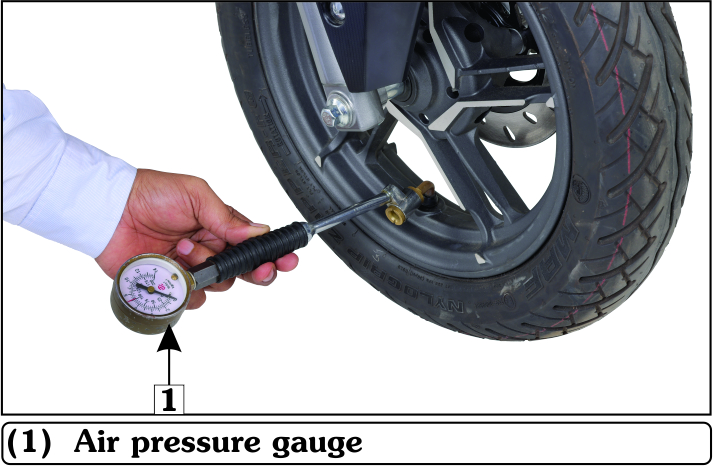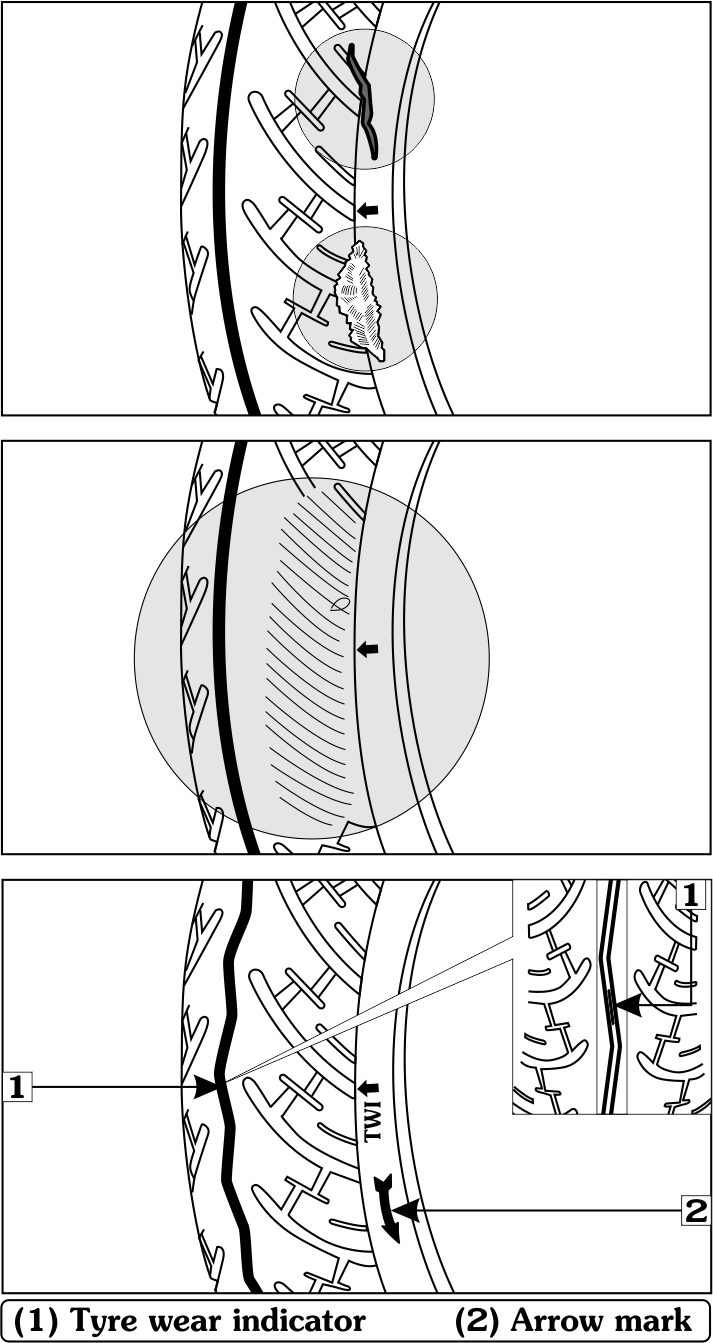Keeping tyres properly inflated provides the best combination of handling, tyre life and riding comfort.
* Generally, under-inflated tyres wear unevenly on the edges on both sides. This adversely affects handling. They are thus likely to fail from being overheated and may result in accidents.
* On the other hand over-inflated tyres also have uneven wear on the edge at the center of the tyre. Over inflation makes your vehicle ride harsh and prone to damage from road hazards and may result in accidents.
We recommend that you visually check tyres before every ride. Take help of nearby Tyre Refilling Station and/or use a gauge (1) to measure air pressure at least once a month or at any time you think/feel that the tyre pressure is low.
Tubeless tyres have some self-sealing ability if they are punctured. However, because leakage is often very slow, you should look closely for punctures whenever a tyre is not fully inflated or is losing air pressure in less than 1 week of inflation

It is recommended to check air pressure when tyres are "cold"- i.e. when the vehicle has been parked for at least three hours. If you check air pressure when your tyres are "warm"- i.e. when the vehicle has been ridden for even a few kilometers, the readings would be higher than what would appear if the tyres were "cold". This is normal, so do not let air out of the tyres to match the recommended cold air pressures given below. If you do, the tyres will be under-inflated.
The recommended “cold” tyre pressures are given in this Owner's Manual:
! CAUTION: -
* Over inflation/Under inflation will affect the performance and ride experience adversely.
* Over/excessive inflation of air may result in tyre bursting which may lead to loss of balance.

Inspection:
Whenever you check the tyre pressure, you should also examine tyre treads & side walls for wear, damage & foreign objects. Look for:
• Bumps or bulges on the side of the tyre or the tread. Replace the tyre if you find any bumps or bulges.
• Cuts, splits or cracks in the tyre. Replace the tyre if you can see fabric or cord.
Tread wear
Replace tyres immediately when the wear indicator (1) appears on the tyre. The tread limits are :
* Minimum tread depth: Front: 1.5 mm Rear: 1.5 mm.
* Check the tread wear indicator for tyre wear.
Unidirectional tyres | Whenever the tyre is removed and put back in case of puncture, ensure the arrow mark (2) on the tyre is in the same direction as that of forward rotation of wheel during ride.

Tyre repair
Repairing a puncture or removing a wheel requires special tools and technical expertise. If a tyre is punctured or damaged, it is advised to visit nearest tyre manufacture workshop/ VIDA authorized Workshop/any suitably tubeless tyre expert repair shop.
A tyre that is repaired either temporarily or permanently, will have lower speed tolerance and performance limitation as compared with a new tyre. This is quite normal. After an emergency repair, always have the tyre inspected at our authorized dealer and replace the tyre if suggested.
You should not exceed 70 km/hour for the 1st 24 hours or 80 km/hour at any time thereafter.
NOTE : -
For repair and replacement of tyre it is advised to visit your VIDA Authorized Workshop.
Important safety reminders: -
• Do not install a tube inside a tubeless tyre on this vehicle. It will result in excessive heat buildup, which can cause the tube to burst and result in serious accidents
• Use only tubeless tyres on this vehicle. The rims are designed for tubeless tyres only and during hard acceleration or braking, a tube type tyre could slip off the rim and cause the tyre to rapidly deflate, causing unsafe circumstances.
Warning: -
* You are advised to limit your speed below 70 km/hour always.
* Once repairs are carried out on Tyre, your safe weight carrying capacity (load) may not be as good as that on new tyre.
* If you decide to have the tyre replaced, be sure the wheel is balanced before you ride.

